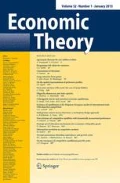Summary.
We show the existence of a competitive equilibrium in an economy with many consumers whose preferences may change over time. The demand correspondence of an individual consumer is determined by the set of subgame-perfect equilibrium outcomes in his intrapersonal game. For additively separable preferences with concave period utility functions that are unbounded above, this demand correspondence will satisfy the usual boundary conditions. Whenever consumers can recall their own mixed actions, this correspondence is convex-valued. This ensures the existence of a symmetric competitive equilibrium.
Similar content being viewed by others
Author information
Authors and Affiliations
Corresponding author
Additional information
Received: 29 July 2004, Revised: 17 November 2004,
JEL Classification Numbers:
D51, D91, C73.
Correspondence to: Thomas Mariotti
We thank Michele Piccione for useful comments and suggestions. The views expressed herein are those of the authors and not necessarily those of the Federal Reserve Bank of Minneapolis or the Federal Reserve System.
Rights and permissions
About this article
Cite this article
Luttmer, E.G.J., Mariotti, T. Competitive equilibrium when preferences change over time. Economic Theory 27, 679–690 (2006). https://doi.org/10.1007/s00199-004-0586-1
Issue Date:
DOI: https://doi.org/10.1007/s00199-004-0586-1


